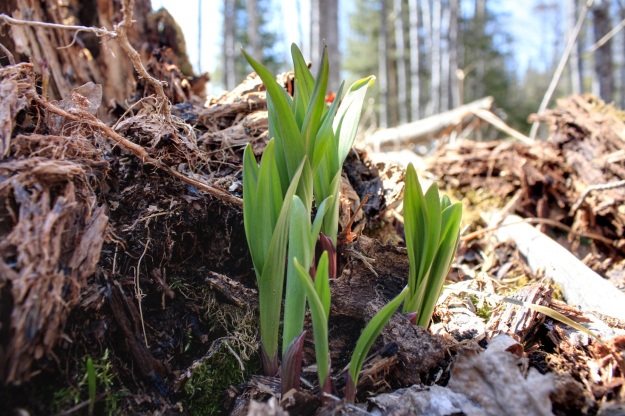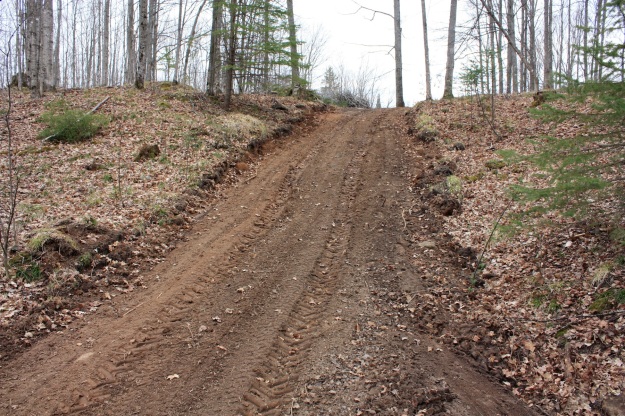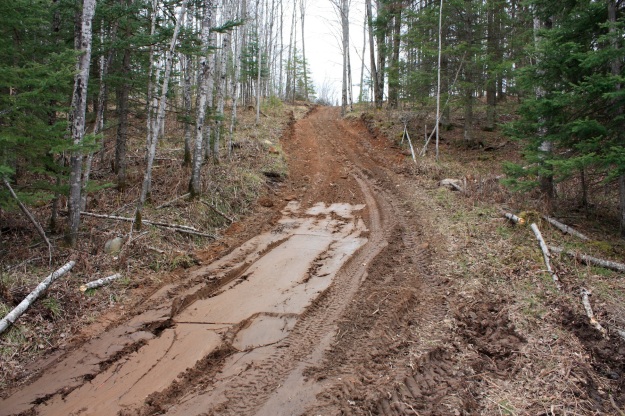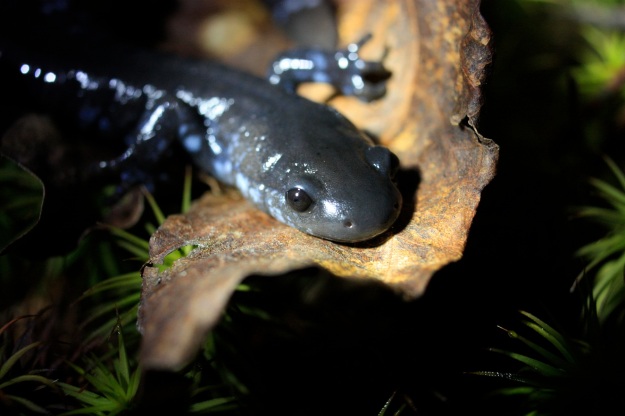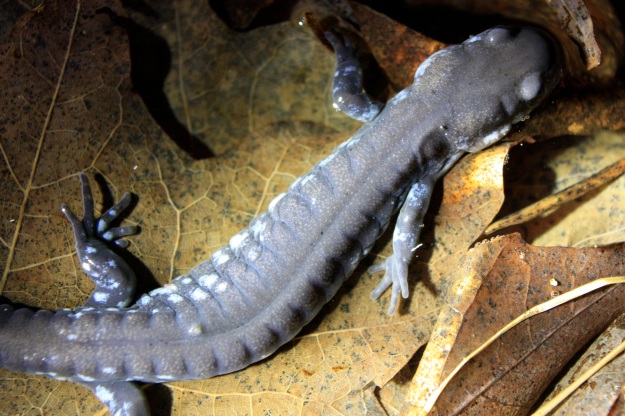5.1.2011 – Sunday
Dad and I arrived around noon on Friday and stayed through mid-morning Sunday. The weekend trip didn’t have any ambitious goals or projects in the works. Some tractor work was done, mostly trail improvement or minor adjustments here or there to uneven ground to provide access to groups of maple trees that we plan to tap in the upcoming years. And of coarse I had my camera gear with.
Upon our arrival to the cabin (I should say my arrival, the ol’ man lives up here for 1/3 of the total days in a year) the first thing noticed was olfactory: the leek is out in force. Some of the maple ridges in the area are completely covered with leek, which smells strongly of onion. As a caution, it can be used in soup, and local wisdom states that the taste and olfactory side effects may be noted by you or your significant other for up to three days.
Also spreading green throughout the forest are numerous species of mosses.
Since I was looking into insurance (getting married and moving to a new town can really play merry hob with this), I asked the ol’ man if our panels were insured – cause, ya know, a tree could fall on them or something like that. Sure enough, we pull into the drive and find a wind-felled maple. The top fifteen feet could have easily reached the panels. Good thing it missed. I can only imagine my dad trying to explain to the insurance company that our panels got mauled by a tree less than a week after buying a policy to cover them. Nonetheless, we feel a bit better knowing our panels are covered.
Dad spent a good part of Friday raking the lawn. One perk of living in the woods is that you can simply rake the leaves until you’re no longer standing on the lawn. No need to make piles or transport them somewhere else.
This four wheeler trail sneaks off the corner of our driveway and connects to the old clearing where the old cabin used to stand. Taking a right at the brush pile leads to “The Slope” – a formidable barrier to all things with wheels (at least on the way up; and especially in winter and spring).
The slope received considerable attention this weekend. Making use of the 33HP Ford and the correct application of loader and back blade, the gully that used to make up the trail was coaxed into a somewhat level roadway. I also worked hard to widen the trail, and achieve a grade that would encourage the water to run down the side of the trail instead of down the center. Not sure how well I achieved the latter. I suppose we’ll just have to wait and see.
Frost. It’s still here.
In the shadow of the hill, insulated by some spruce and balsam trees, there is a basin of frozen earth on top of which water has collected to form a thick, viscous, layer of clay. At the bottom of the slope, more specifically, the bottom of the “second step” as well call it, a pseudo-sink hole has formed. Dad and I often refer to the slope trail as being divided into two steps. The bottom step has long been the most difficult to ascend, partly due to traction and partly due to the grade. Between the steps there is a 20 foot or so portion of trail that is level (at least by our standards). The level section between the steps serves as a place to gain momentum (slam down the throttle, lean forward, and think tractive thoughts). As you can imagine, the degree of tractive thoughts needed to ascend with a trailer vary widely from season to season. It’s not uncommon to call on the aid of a second four wheeler and a tow strap to complete the ascent (which works better when the ol’ man remembers to put his four wheeler into four wheel drive). Back to the pseudo-sink hole: In my effort to decrease the severity of the slope of the first step I cut into the top of the first step with the loader and pushed the excess earth down to the bottom of the slope. Moving soft clay on top of already soft clay, while it seamed attractive at the time, made it impossible to ascend the hill with the tractor. A foot or more of clay is not an impassable obstacle for a four wheel drive compact tractor, but when that clay is on top of a layer of frost reinforced clay there is effectively zero traction. The treads, designed to be self cleaning of mud and dirt, guarantee that the tires will excavate enough clay to get down to the frost. After a day to dry I was able to fix up the top step very well and widen the bottom step. As the picture below shows, the built up clay at the bottom of the second step alleviated the deep gully with an impassible clay sink hole. It looks smooth and shiny as a result of a last ditch effort to repair my ruts by back smoothing with the bucket.
And a quick note: hills and uneven terrain can be extremely dangerous and it is important to consider the surroundings and familiarity with the power equipment. I had at my disposal low range, a seat belt, ROPS bar, rear differential lock, and plenty of practice making previously functional trails impassable.
I made a few wide field of view images of and around the pond. Each of these panoramas is composed of 2 or 3 separate images. For reference, the pond is typically about 60×90 feet. With the water 24 to 36 inches above the usual water line, the pond has grown roughly 15 feet in all directions.
To the left of the balsam is un-thinned forest. The right has been managed.
With high water, sunny skies, and the shadow of winter retreating, the animals are returning. The first hint that the forest was beginning to rewaken was evident upon arrival. I thought I could faintly detect tree frogs calling. A little later I found a shallow wetland on State land to the Southwest of the old cabin clearing.
The frogs were too far into the marsh for hiking boots. When night fell, the chorus was enough to make quick work of the cabin windows and dominate all other ambient noises. Now they were much closer to the cabin. The high waters of the pond had attracted dozens of Spring Peepers (Hyla crucifer) to descend from the trees and shrubs to take refuge in its grassy banks.
I travel prepared for my hobbies. I had my Canon XSi 12.2MP camera with a 12mm Kenko extension tube mounted between a 18-55mm f3.5-5.6 image stabilized lens and the camera body. I also had a 130 lumen LED Princeton Tec Apex headlamp and a 500 lumen LED Sunwayman handheld flashlight at the ready. While the headlamp was helpful, the handheld flashlight really got the task done; allowing me to throw light from the side to enhance the textures of skin and control reflections. I found two spotted salamanders (Ambystoma maculatum) and photographed one of them.
Macro photography was not the only game in town (or woods). In the forest, and on the water, there were plenty of larger and more wary animals. There are of coarse several species of duck and a handful of geese on the flowage. This lone loon really caught my eye, and had me scrambling to get out of the truck. Once I had overcome the impediment of automatic door locks I was able to get a few decent pictures of our rare guest.
White tail deer are also a common sight. Just off of the gravel roads near the cabin, these fellas were reluctant to give up a spot in the forest where some food was to be found. Eventually they would notice me noticing them and trot off until they felt hidden and unnoticed again. Here is one noticing me noticing her.

